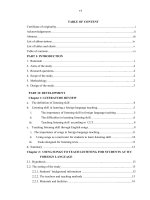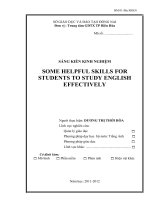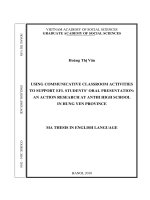Support for Students Exposed to Trauma docx
Bạn đang xem bản rút gọn của tài liệu. Xem và tải ngay bản đầy đủ của tài liệu tại đây (1.42 MB, 200 trang )
This document and trademark(s) contained herein are protected by law as indicated in a notice appearing later in
this work. This electronic representation of RAND intellectual property is provided for non-commercial use only.
Unauthorized posting of RAND PDFs to a non-RAND Web site is prohibited. RAND PDFs are protected under
copyright law. Permission is required from RAND to reproduce, or reuse in another form, any of our research
documents for commercial use. For information on reprint and linking permissions, please see RAND Permissions.
Limited Electronic Distribution Rights
This PDF document was made available from www.rand.org as a public
service of the RAND Corporation.
6
Jump down to document
THE ARTS
CHILD POLICY
CIVIL JUSTICE
EDUCATION
ENERGY AND ENVIRONMENT
HEALTH AND HEALTH CARE
INTERNATIONAL AFFAIRS
NATIONAL SECURITY
POPULATION AND AGING
PUBLIC SAFETY
SCIENCE AND TECHNOLOGY
SUBSTANCE ABUSE
TERRORISM AND
HOMELAND SECURITY
TRANSPORTATION AND
INFRASTRUCTURE
WORKFORCE AND WORKPLACE
The RAND Corporation is a nonprofit research
organization providing objective analysis and effective
solutions that address the challenges facing the public
and private sectors around the world.
Visit RAND at www.rand.org
Explore RAND Health
View document details
For More Information
Purchase this document
Browse Books & Publications
Make a charitable contribution
Support RAND
This product is part of the RAND Corporation technical report series. Reports may
include research findings on a specific topic that is limited in scope; present discus-
sions of the methodology employed in research; provide literature reviews, survey
instruments, modeling exercises, guidelines for practitioners and research profes-
sionals, and supporting documentation; or deliver preliminary findings. All RAND
reports undergo rigorous peer review to ensure that they meet high standards for re-
search quality and objectivity.
HEALTH
PROGRAM MANUAL
Support for Students Exposed
to Trauma: The SSET Program
Group Leader Training Manual, Lesson Plans,
and Lesson Materials and Worksheets
Lisa H. Jaycox
•
Audra K. Langley
•
Kristin L. Dean
Sponsored by the National Institute of Mental Health
The RAND Corporation is a nonprofit research organization providing objective analysis
and effective solutions that address the challenges facing the public and private sectors
around the world. RAND’s publications do not necessarily reflect the opinions of its
research clients and sponsors.
R
®
is a registered trademark.
© Copyright 2009 RAND Corporation
Permission is given to duplicate this document for personal use only, as long as it is unaltered
and complete. Copies may not be duplicated for commercial purposes. Unauthorized
posting of RAND documents to a non-RAND Web site is prohibited. RAND
documents are protected under copyright law. For information on reprint and linking
permissions, please visit the RAND permissions page (
permissions.html).
Published 2009 by the RAND Corporation
1776 Main Street, P.O. Box 2138, Santa Monica, CA 90407-2138
1200 South Hayes Street, Arlington, VA 22202-5050
4570 Fifth Avenue, Suite 600, Pittsburgh, PA 15213-2665
RAND URL:
To order RAND documents or to obtain additional information, contact
Distribution Services: Telephone: (310) 451-7002;
Fax: (310) 451-6915; Email:
This work was sponsored by the National Institute of Mental Health under contract No.
MH072591. The research was conducted in RAND Health.
Library of Congress Cataloging-in-Publication Data
Jaycox, Lisa.
Support for students exposed to trauma : the SSET program / Lisa H. Jaycox, Audra Langley,
Kristin L. Dean.
p. cm.
ISBN 978-0-8330-4732-8 (pbk. : alk. paper)
1. Middle school students—Mental health services—United States. 2. Middle school students—
Counseling of—United States. 3. Psychic trauma in adolescence—Treatment—United States. 4. Teacher
participation in educational counseling—United States. I. Langley, Audra. II. Dean, Kristin L. III. Title.
LB3430.J39 2009
373.17'1—dc22
2009021948
iii
Preface
ese materials were adapted from a manualized group program called the Cognitive-Behav-
ioral Intervention for Trauma in Schools, or CBITS, which was developed and initially eval-
uated in the Los Angeles Unified School District. at program was developed for use by
school-based mental health professionals, whereas the Support for Students Exposed to Trauma
(SSET) program, the subject of this book, can be used by any school personnel with the time
and interest to work with students affected by trauma.
To adapt and develop the SSET program for teachers and school counselors, we consulted
with school and mental health experts, conducted focus groups with school staff and parents,
and used their feedback to develop the program and pilot test it in two Los Angeles Unified
School District middle schools. Results of the pilot test were promising, showing that teachers
and school counselors were able to deliver the program as desired, that students and parents
were satisfied with the support groups, and that children showed small improvements in their
distress symptoms.
1
We thank the many individuals who contributed to this project: Bradley Stein, Mar-
leen Wong, Stefanie Stern, Steven Evans, Phyllis Ellickson, Sheryl Kataoka, Barbara Colwell,
Roberta Bernstein, Pia Escudero, Fernando Cadavid, Suzanne Blake, Daryl Narimatsu, Patri-
cia Fuentes-Gamboa, Yvette Landeros, Lajuana Worship, Maria Sanchez, Kathy Scott, Rachel
Braude, Brian Spencer, Kris Evans, Carla Heiland, Benin Williams, Jonathan Brown, Windy
Wilkins, and the many parents and students who helped us develop this manual.
is book has three parts: a training manual for SSET leaders and other implementers,
the SSET lesson plans, and the SSET lesson materials and worksheets that accompany each
lesson. e training manual can be read first, followed by each lesson plan and its accompa-
nying materials as they are referenced in the plan. e materials and worksheets are repro-
ducible for use when implementing the SSET program. ey can be either photocopied
directly from this book or printed out directly from the RAND Corporation’s Web site at
/>is work was sponsored by the National Institute of Mental Health under contract
No. MH072591. e research was conducted in RAND Health, a division of the RAND Cor-
poration. A profile of RAND Health, abstracts of its publications, and ordering information
can be found at www.rand.org/health.
1
Jaycox, L. H., Langley, A. K., Stein, B. D., Wong, M., Sharma, P., Scott, M., Schonlau, M. (2009). Support for Students
Exposed to Trauma: A Pilot Study. School Mental Health. Published online on March 21, 2009.
v
Contents
Preface iii
Glossary of Terms
vii
GROUP LEADER TRAINING MANUAL by Audra K. Langley, Lisa H. Jaycox, and Kristin L. Dean
Prevalence and Impact of Exposure to Violence 3
What Is SSET?
5
Goals and eory of SSET
11
Selecting Students for SSET
15
Forming and Scheduling Groups
19
Dealing with Trauma and Violence Exposure
25
Working with Students Who Have Been Multiply Traumatized or Abused
27
Disclosure by Group Members
29
Disclosure by Group Leaders
31
Clinical Backup and Consultation
33
Special Student and Group Issues
37
Matching Problems and Goals
43
Homework Assignments
45
Ending the Group
47
Scenarios: What to Do When You Can’t ink of an Example
49
LESSON PLANS by Lisa H. Jaycox and Audra K. Langley
Lesson One: Introduction 53
Lesson Two: Common Reactions to Trauma and Strategies for Relaxation
61
Lesson ree: oughts and Feelings
69
Lesson Four: Helpful inking
77
Lesson Five: Facing Your Fears
85
Lesson Six: Trauma Narrative, Part One
93
Lesson Seven: Trauma Narrative, Part Two
99
Lesson Eight: Problem Solving
105
Lesson Nine: Practice with Social Problems and the Hot Seat
113
Lesson Ten: Planning for the Future and Graduation
119
LESSON MATERIALS AND WORKSHEETS by Lisa H. Jaycox and Audra K. Langley
Lesson One: Introduction 127
vi Support for Students Exposed to Trauma: The SSET Program
Lesson Two: Common Reactions to Trauma and Strategies for Relaxation
135
Lesson ree: oughts and Feelings
141
Lesson Four: Helpful inking
147
Lesson Five: Facing Your Fears
153
Lesson Six: Trauma Narrative, Part One
161
Lesson Seven: Trauma Narrative, Part Two
169
Lesson Eight: Problem Solving
177
Lesson Nine: Practice with Social Problems and the Hot Seat
183
Lesson Ten: Planning for the Future and Graduation
187
vii
Glossary of Terms
Brainstorming e act of eliciting any idea that pops into one’s head
that may be relevant to the situation. Should include all
thoughts without judgment.
Distraction e act of engaging in one behavior to take one’s mind off
another. May be used to help one endure anxiety during an
exposure or as an option for managing a difficult social sit-
uation. Examples of distraction include listening to music,
talking to a friend, playing a video game, thinking about
something else, and watching TV or a movie.
Fear ermometer A tool for describing levels of negative feelings (e.g., fear,
anxiety, worry, nervousness, upset) on a scale from 0 to
10, where 0 is “no problem at all; feeling good,” and 10 is
“feeling maxed out; the worst.” Provides a common lan-
guage for group members to describe and monitor their
feelings; allows the group leader to gain insight into and
monitor changes in an individual’s anxiety levels.
Helpful thoughts oughts that are based on a realistic assessment of the
situation, including checking the objective facts, conduct-
ing an assessment of the most reasonable explanation, and
reviewing the history of similar occurrences.
Positive images Ideas or mental pictures that are associated with feelings
of happiness, contentment, tranquility, calm, and relax-
ation. Individuals may imagine themselves in a setting
or situation that conjures these emotions, or they may
simply imagine a picture that reminds them of this state of
relaxation.
Problem solving e act of figuring out ways to best manage difficult situ-
ations. Includes brainstorming solutions, evaluating all
proposed options, implementing the strategy deemed best
to reach individual goal while maintaining the safety of all
involved, and limiting negative associated consequences.
viii Support for Students Exposed to Trauma: The SSET Program
Relaxation Exercise(s) directed at reducing physiological arousal/ten-
sion. May include deep breathing, progressive muscle tens-
ing and relaxing, and positive visual imagery.
Social support Care provided to an individual by another person (e.g., a
family member, a friend, a neighbor, a teacher).
SSET Support for Students Exposed to Trauma.
ought stopping e deliberate act of willing oneself to stop a current
thought. Typically done by visualizing a stop sign, saying
“Stop!” out loud or to oneself, or doing something else
that serves as a cue to stop the thought (such as snapping
a rubber band or banging one’s hand on a table, book, or
desk).
Trauma narrative An individual’s relating of the story of his or her traumatic
experience. A written, verbal, or pictorial expression of the
occurrences that comprised one’s traumatic event.
Trauma/traumatic event An event that is sudden and frightening and that poses
a threat of injury or death to oneself or others. Usually
makes an individual feel terrified, horrified, or helpless
when it is happening.
Unrealistic thoughts oughts that are not based on available objective evidence
and may not be reasonable for the situation or context.
GROUP LEADER TRAINING MANUAL
Audra K. Langley
Lisa H. Jaycox
Kristin L. Dean
3
Prevalence and Impact of Exposure to Violence
Exposure to community and interpersonal violence is a public health crisis and adversely affects
many children in our country and in our communities. A national study of 7–12th graders
revealed that
12 percent of youth had a knife or gun pulled on them in the past year •
5 percent had been stabbed or cut•
1.5 percent had been shot at.•
1
ere are some children who are at greater risk for violence, including
boys•
older children •
children with early behavioral problems •
youth living in urban areas•
children with lower socioeconomic status.•
2
Following direct exposure to or after personally witnessing a traumatic event, many chil-
dren experience symptoms of a disorder called Post-Traumatic Stress Disorder (PTSD); a
substantial minority of these children show clinical levels of PTSD. Symptoms include
re-experiencing the traumatic event (i.e., having flashbacks and/or intrusive thoughts about •
the event, having nightmares, becoming upset by exposure to reminders of the event)
physiological hyperarousal (i.e., feeling startled more easily, being on guard for danger, •
getting angry/irritated easily, having trouble sleeping, poor concentration)
avoidance/numbing (i.e., trying to avoid thoughts, people, and other reminders of the •
trauma; feeling numb emotionally; not remembering all of what happened).
In addition to PTSD, exposure to violence is also associated with depression, behavioral
problems, substance abuse, and poor school performance in children. Among adolescents,
approximately 6 percent of boys and 4 percent of girls meet clinical criteria for a diagnosis
of PTSD. ese rates are much higher for youth in urban areas, where they range from 24
percent to 67 percent. Moreover, 75 percent of youth with PTSD have additional mental
health problems.
1
Gutterman, N. B., Hahm, H. C., & Cameron, M. (2002). Adolescent victimization and subsequent use of mental health
counseling services. Journal of Adolescent Health, 30(5): 336–345.
2
Schwab-Stone, M., Chen, C., Greenberger, E., Silver, D., Lichtman, J., & Voyce, C. (1999). No Safe Haven II: e effects
of violence exposure on urban youth. Journal of the American Academy of Child & Adolescent Psychiatry, 38(4), 359–367.
5
What Is SSET?
Support for Students Exposed to Trauma (SSET) is a series of ten support groups that use a struc-
tured approach to reduce distress resulting from exposure to violence. It includes a wide variety
of skill-building techniques. ese techniques are geared toward changing maladaptive thoughts
(i.e., toward challenging negative thinking, stopping automatic negative thoughts, distracting
from negative patterns of thinking) and promoting positive behaviors (i.e., improving social
skills, increasing pleasant activities, decreasing avoidance of difficult situations or thoughts).
Each lesson follows a similar format:
Lessons are structured. • e agenda set for each lesson includes an independent prac-
tice review, teaching new skills or practicing other skills, and an independent practice
assignment.
Lessons rely on collaboration between the group leader and the students.• e group
leader acts as a “coach” to help the students develop new skills and find ways to practice
them effectively.
Lessons emphasize the practice of new techniques during lessons and between les-•
sons. Independent practice assignments are assigned between lessons and are important
for consolidating skills learned in group.
e SSET program is intended to be time-limited.• Groups encompass ten 1-hour
meetings. e goal is to enable the students to continue practice on their own after the
group ends.
What Problems Are Addressed by SSET?
is program is intended for use with groups of students who have experienced significant
traumatic experiences and are suffering from symptoms of PTSD, including re-experiencing
the trauma, physiological hyperarousal, and numbing or avoidance. Since low mood, anx-
iety or nervousness, and impulsive or angry behavior often accompany symptoms of PTSD,
many of the techniques are targeted toward those problems as well. us, the following types
of problems are addressed:
anxiety or nervousness•
withdrawal or isolation•
low mood•
acting out in school•
impulsive or risky behavior.•
6 Support for Students Exposed to Trauma: The SSET Program
What Problems Are Not Intended to Be Addressed by
SSET?
e SSET program is not intended for use with
students in crisis who need an immediate referral to counseling•
students with severe behavior problems that would make it hard for them to participate •
in a support group without disrupting it
students with severe cognitive limitations that put them below the 4th-grade level in read-•
ing comprehension
students whose primary problem is child abuse. (See “Working with Students Who Have •
Been Multiply Traumatized or Abused,” pp. 27–28.)
Who Implements SSET?
SSET is designed to be implemented by teachers or school counselors who have an interest in
the mental health of their students and have good rapport with their students. In addition to
the implementer, it is important to have support from the school principal and other staff, who
will need to be able to understand the reason for the groups, the plan for implementation, and
how confidentiality will be handled. A very important piece of the SSET planning is form-
ing an ongoing relationship with a clinician who can provide clinical backup support for the
groups at the following times: at the beginning when students are identified for SSET, as the
program is implemented in case any problems emerge, and at the end to ensure continuity for
students who need additional support. Clinicians can be on staff at the school (e.g., a school-
based social worker), available through the district (e.g., a psychologist or social worker at the
district level), or contractually arranged with a community provider.
What Age Groups Benefit from SSET?
is program was designed for use in middle school (ages 10–14). It may be useful for younger
students (down to grade 4) or older students (up to grade 9), but has not been used in those
age groups to date.
What Skills Are Taught by SSET?
An outline of the new concepts taught in each lesson is provided in Table 1 on the next page.
Group Leader Training Manual 7
Group Format and Management
Student support groups are formatted to last approximately one hour. e usual format is to
convene groups of identified students during the school day, preferably during a nonacademic
period. Groups can also be held after school if such obstacles as transportation concerns can
be addressed. Groups are usually held once per week. In some groups, it is helpful to write an
outline of the lesson’s activities on the chalkboard at the beginning of the lesson. It may also
be useful to develop a point system to increase participation in activities. e group members
who complete the most activities can be rewarded, or incentives for activities participation can
be provided throughout the program. Any such group-management techniques can be imple-
mented to augment group participation and compliance.
Materials Needed
Notebooks containing the program handouts should be created for the participants, and extra
copies should be made in case students lose or misplace their notebooks. For each lesson, have
a chalkboard or large writing pad and extra copies of the relevant worksheets. Special materi-
als required for each lesson are identified in the Teacher Preparation section of each lesson in
the Lesson Plans section. Depending on the time of the intervention, it could be important to
provide a snack or drinks for the participants.
Table 1—Lesson Outline
Lesson Number Lesson Content
One Introduction
Two Common reactions to trauma and strategies for relaxation
Three Thoughts and feelings
Four Helpful thinking
Five Facing your fears
Six Trauma narrative, part one
Seven Trauma narrative, part two
Eight Problem solving
Nine Practice with social problems and the Hot Seat
Ten Planning for the future and graduation
8 Support for Students Exposed to Trauma: The SSET Program
Parent Participation
Parents are not involved in the group itself but should be engaged as much as possible through
telephone contact. e first phone call to parents should occur at the beginning of SSET, pref-
erably before the group lessons begin, but at the latest before Lesson Two. During this call,
describe common reactions to stress or trauma, explain SSET and its procedures, and enlist
parental help with activity assignments and group attendance. Subsequent phone calls can be
made as needed. ey may prove helpful in preparation for the real-life exposure activities in
Lesson Five and can also be used to review a student’s progress and suggest additional treat-
ment, if necessary.
Confidentiality
Unlike many other activities at school, the SSET groups are designed to be confidential. is
means that what is shared in group stays in group, and even the group leader is expected
to keep information about students confidential or private. ere are two exceptions to
this rule:
If you determine that a student might be harmed or might harm others, you will need 1.
to follow school protocols to protect the student or others. (For example, if the student
is having a medical emergency, or if he or she tells you about suicidal intent.)
If the student tells you about child abuse, you must follow school protocols and inform 2.
the study team as required by law.
e following types of information are expected to be kept confidential:
scores on or responses to the screener measures•
Only summary information can be shared with parents at the beginning of the group –
in order to explain the group’s purpose. Otherwise, the overall scores or responses of
students to any of the items on the screener measures are private.
scores on or responses to any of the assessments•
If you help to collect the assessments, remember that these are private. –
drawings or stories or worksheets generated as part of the group•
All group materials should be stored and locked. ey should not be shown to anyone –
outside of the group.
student’s experiences or statements made in group that they have not discussed in •
public settings
For example, some students may talk freely about their experiences in the hallways and –
classrooms, and if they do that in front of you, you are not bound to keep that informa-
tion private. But if they are only talking about their experiences in the SSET group, or
you are not sure, then you need to keep their experiences and statements private.
inclusion in the group, beyond the need for others to know for logistic purposes •
Group Leader Training Manual 9
For example, you may need to tell another teacher that the student is in group in order –
for the student to be released to you, but you do not need to tell anyone else that the
student is participating in the group.
Note
If someone asks you for information about a student in your SSET group, do
not give it out until you discuss it with the project team.
11
Goals and Theory of SSET
Goals
e goals of the SSET program are to
reduce symptoms of PTSD and other related problems•
build resilience •
build peer and parent support.•
Each of these goals needs to be tailored to the individual student. A review of the
screening questionnaire will help to show student strengths and weaknesses and help this
planning process.
e initial goal of SSET, then, is to decrease the PTSD, depression, and general anxi-
ety symptoms that are interfering with each student’s functioning. For example, if a stu-
dent who has undergone a traumatic event is experiencing intrusive thoughts of the event,
difficulty sleeping, general anxiety, poor concentration, negative ideas about himself or herself,
irritability, and low mood, it is fairly clear that the event is interfering in his or her daily life.
School performance, family and social relationships, and social activities may all be negatively
affected by these symptoms. SSET aims to give students skills that help decrease these symp-
toms and improve their functioning at home, at school, and with friends.
Another goal of SSET is to assist students in maximizing the benefit of their existing
coping skills and in building helpful new life skills in order to cope with the traumatic events
they have encountered. is enables students to gain a sense of coping ability and mastery over
managing their internal symptoms and their environments. As youth become practiced at vari-
ous coping skills, they are then equipped with a “toolkit” from which they can pull various
strategies to apply to different situations or elements of the event or issue they are facing.
A final goal of SSET is to increase levels of peer and parent support. SSET is an oppor-
tunity for youth to share information about their experiences with violence, trauma, or stress
in a very supported way. It is also essential to create a foundation for support from peers and
family members that will extend outside of the group. Participation in the group itself allows
a common bond to develop between peer participants that oftentimes extends outside of the
group. Moreover, some of the group content aims to give students skills for being able to appro-
priately share their experiences with violence, trauma, or stress with trusted others outside of
the group (including trusted friends, family members or caregivers, teachers, and/or other
adults). A common theme running though the SSET program is opening and strengthening
12 Support for Students Exposed to Trauma: The SSET Program
lines of understanding and communication between parents or caregivers and their children.
is is done through education and take-home practice assignments.
SSET, then, aims to target both (1) the symptoms that students are presenting that are
related to PTSD, depression, and behavioral problems and (2) the students’ level of functioning
at school, socially, and within their families. It is also aimed at building buffers, such as coping
skills and peer and parent support, to enable students to deal with past and future events.
The Theory Behind SSET
At a basic level, the theory behind this type of program is that thoughts, feelings, and behaviors
are closely related and can affect each other. is relationship is expressed in Figure 1.
For example, suppose that as you are driving to work you encounter a lot of traffic.
Stress: Traffic on the way to work.
If you are thinking something positive or neutral about a situation, you will likely be feel-
ing a positive emotion and only a little arousal in your body. You will behave accordingly.
oughts: “is should be fine. I’m good at handling this.”
Feelings: Content, relaxed.
Actions: Driving normally.
On the other hand, if you are thinking negative things about a situation and negative
emotions and physical feelings of anxiety arise, you will behave accordingly.
oughts: “I’m going to be late for work. My boss will be mad at me.”
Feelings: Anxious, nervous, agitated.
Actions: Driving fast/aggressively, taking risks, changing your route.
Figure 1—Stress/Trauma/Violence Triangle
What we think
What we do How we feel
Stress
Trauma
Violence
Group Leader Training Manual 13
e relationship between thoughts, feelings, and behaviors is addressed in the SSET pro-
gram, which presents and encourages the practice of skills that shift the way that youth think,
feel, and behave in situations to make their experiences of the situations better, if possible.
We address each of the three components in different ways, as shown in Table 2.
Why Do We Address Thoughts in Trauma Survivors?
Research shows that thinking is disturbed after an extreme trauma or experience with vio-
lence. Two general themes begin to push away normal thoughts:
e world is dangerous. I am not safe. People cannot be trusted.
I can’t deal with this. I’ll never be the same. I am falling apart.
ese two ideas or “themes” in thinking can really interfere with daily life. In the SSET
program, we look for times when these themes are getting in the way and then teach students
to “challenge” them to make sure their thoughts are accurate and balanced. Usually, students
can find a more adaptive, less distressing way of looking at the problems they are facing.
How Do We Reduce Anxiety Related to the Trauma or to
Reminders of the Trauma?
e SSET program reduces anxiety related to the traumatic experience by capitalizing on the
human process called habituation. e human body cannot stay highly aroused for long peri-
ods of time—the natural process is for anxiety to gradually decline.
Table 2—How SSET Addresses the Three Components
Component SSET Teaching
Thoughts Teach students to notice their thinking.•
Teach students to challenge their thinking, or to challenge their harmful •
thoughts to have more balanced and accurate thoughts.
Teach students to stop negative or problematic thoughts that are getting •
in their way.
Feelings Teach students to relax their bodies.•
Help reduce the anxiety related to the trauma that happened to them.•
Help reduce the anxiety students feel when they are reminded of what •
happened to them.
Behaviors Teach students to consider alternatives for what to do when there is a •
problem.
Teach students to decide on a plan of action and carry out their desired •
plan.
14 Support for Students Exposed to Trauma: The SSET Program
Imagine climbing to the top of a very tall tower. Most of us would feel some anxiety or
fear at first. But as you stay up there (and nothing bad happens), gradually that fear or anxiety
will decrease. If you stay up there for a few days, it will become a second home. is demon-
strates the way that the body adjusts to situations that start out frightening (as long as nothing
bad happens to re-arouse the fear).
In the SSET group, we work toward students “getting used to” writing, thinking, or
talking about their trauma in the safety of the support group. us, their anxiety gradually
decreases. As an added bonus, the writing and sharing can also enable students to process or
digest their experience. at is, the more they are able to process the experience—first in a fac-
tual, less threatening form, and later by adding details and associated emotions—the easier it
will become to continue doing so and the less these thoughts and the anxiety they cause will
interfere with their functioning. e goals are for students (1) to feel that although a terrible
thing happened to them, it cannot hurt them now and (2) to understand that thinking, talk-
ing, or writing about what happened is not dangerous and gets easier the more they are able
to do it.
SSET does the same thing for reminders of the trauma, such as situations involving
people, places, or things that make the student feel anxious or upset because they are remind-
ers of what happened. In the SSET program, students identify the situations they are avoiding
and set about deliberately confronting them instead of avoiding them. As students are gradu-
ally able to approach and endure these situations without anything bad happening, they gain a
sense of mastery over the situation, and their associated anxiety decreases.
15
Selecting Students for SSET
SSET is intended for middle school students who have experienced a significant trauma and
who are experiencing considerable distress related to that event. We recommend using a screen-
ing instrument among as many students as possible in the student body in order to identify
students in need of this program. We usually use a version that includes
a scale assessing exposure to community violence (but not violence at home) and other •
traumatic events
a scale assessing anxiety and nervousness related to that exposure.•
ere are many different scales that would be appropriate for this process, and each has
its own guideline for scoring.
3
Because students’ responses on self-report measures are not always valid, it is important
to follow up the screening process with a personal interview in which you review and confirm
the responses with the student and make sure that the student is interested in participating in
and appropriate for the SSET program. Please refer to the instructions provided in “Forming
and Scheduling Groups” (pp. 19–23).
In inner-city schools, it is expected that many students (upwards of 20 percent) would
benefit from this kind of intervention. In other areas, the proportion of students who would
benefit may be smaller. If an entire school has been affected by a disaster or violence, it is pos-
sible that many more than 20 percent of students would benefit from this kind of interven-
tion. In these cases, school counselors should wait three to six months after the trauma before
identifying those in need.
Who Gives Permission for Screening?
Parents give permission for screening prior to it taking place, and they are told about the pur-
pose (i.e., identifying students who might benefit from the SSET program).
We provide a sample letter in Figure 2 on the next page, but you should follow your
school’s procedures that establish the types of letters and permissions required.
3
e measures we used in our pilot study for SSET are available upon request from Lisa Jaycox ().









